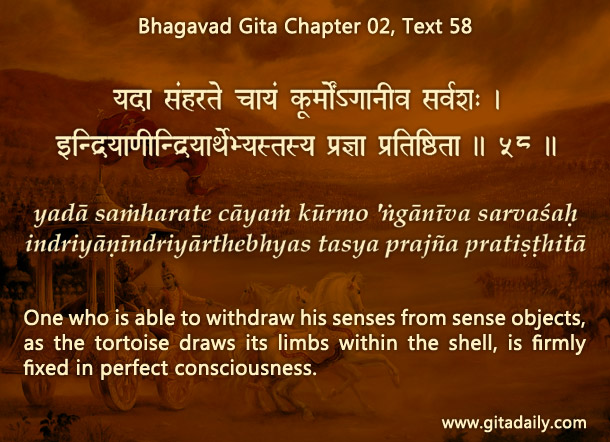For cultivating self-discipline, the Bhagavad-gita recommends two distinct approaches. Let’s understand these approaches.
The outside-in approach: When discussing how we can stay steady amid worldly temptations, the Gita (02.58) urges us to withdraw our senses, just as a tortoise withdraws its limbs. Here, the Gita refers to our knowledge-acquiring senses (jnanendriyas). These are our eyes, ears, nose, tongue and skin, through which we perceive the outer world. If we learn to regulate the inputs coming in through these senses, we can avoid unnecessary inner disturbances, thereby making self-discipline easier. Suppose we tend to overeat a particular delicacy that is sold on the path of our daily commute. We can avoid the disruptive temptation by choosing to commute via an alternative path.
The inside-out approach: When discussing how we can function in the world, the Gita (02.67) cautions that our roaming senses can carry away our intelligence, just as a stormy wind can carry away a boat. Here, the Gita refers to our action-performing senses or working senses (karmendriyas). These are our hands, legs, voice, reproductive organ and excretory organ. Through these senses, we translate our inner emotions and intentions into outer actions. When we strive to be disciplined, we want our actions to express our deeper intentions, not our superficial emotions. Suppose we feel angry with someone. If we give in to the stormy impulse to lash out at them with our words or hands, that aggression may unnecessarily aggravate the problem. Instead, if we resolve to keep a leash on our working senses, the inner anger will gradually decrease. Then, we can find a way to express our concerns in a way that makes things better, not worse.
One-sentence summary:
The outside-in approach to self-discipline ensures that avoidable outer temptations don’t disturb us internally; the inside-out approach to self-discipline ensures that our inner disturbances don’t lead to avoidable outer disruptions.
Think it over:
- In pursuing self-discipline, how can the outside-in approach help?
- In pursuing self-discipline, how can the inside-out approach help?
- List one situation where you can use each of these two approaches.
***
02.58: One who is able to withdraw his senses from sense objects, as the tortoise draws its limbs within the shell, is firmly fixed in perfect consciousness.
To know more about this verse, please click on the image


Leave A Comment